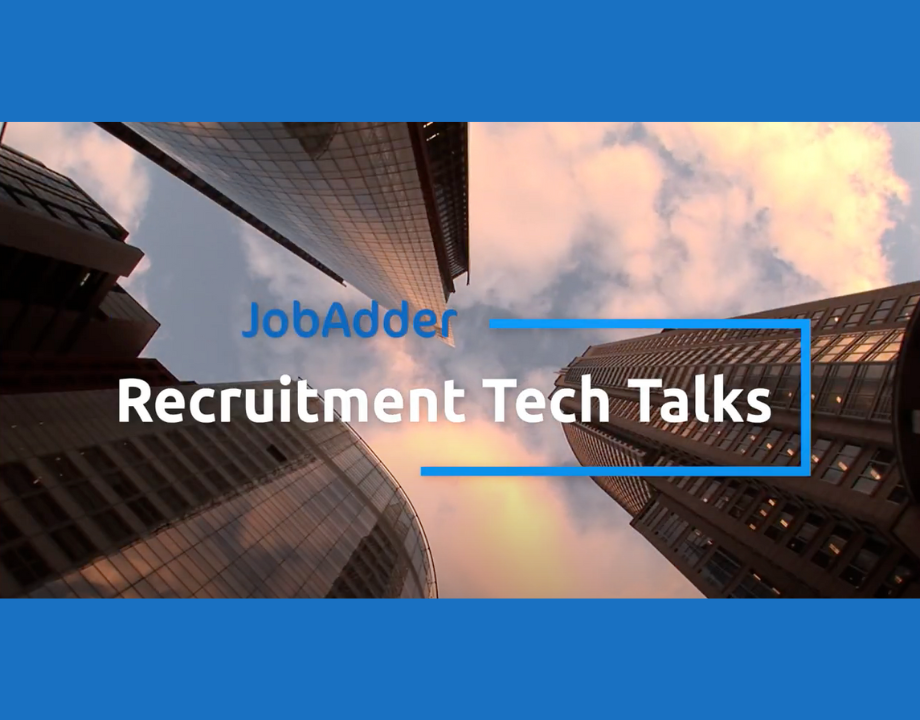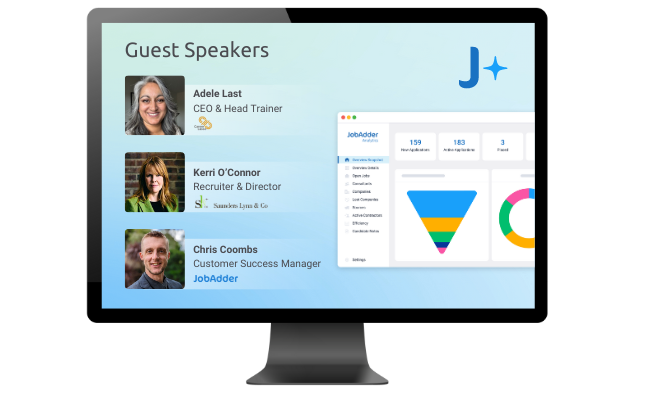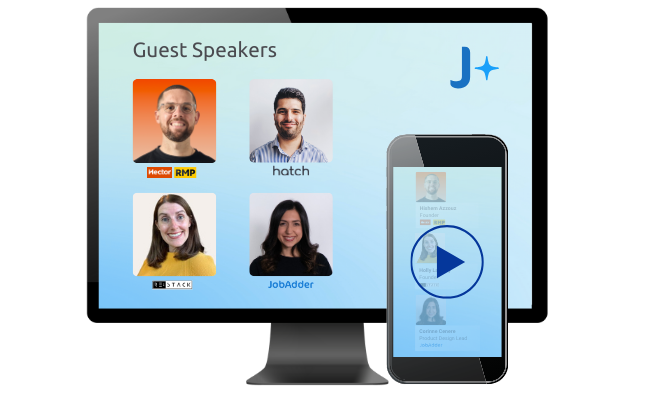Resource
Recruitment Tech Talks video: Recruitment marketing and proactive recruitment

JobAdder’s CEO Martin Herbst and global recruitment advisor Greg Savage discuss proactive recruitment and building and nurturing your talent pool in this exclusive interview series, Recruitment Tech Talks. Stay till the end to see behind-the-scenes insights from JobAdder’s Head of Product, Tom Dyson.
Transcript of Recruitment Tech Talks: Recruitment Marketing and Proactive Recruitment
Martin: Welcome to Recruitment Tech Talks. I’m here with Greg Savage, Greg, one of the things that we saw in the report is that during the pandemic, there was a big rise in the actual use of proactive sourcing by a lot of agencies.
In more recent quarters or months, we’ve seen that actual level go back down again. What do you make of this?
Greg: Well, the first thing I’d say is that, it’s a problem. We have to remember, that when you boil it all back, for recruitment agencies, your real value is to find candidates that your clients can’t.
Let me be perfectly frank about it. And you know this very well. If organisations could find candidates easily, and they’ve all got in-house teams, and they’ve all got the same tools like SEEK and LinkedIn, if they could find them easily, they wouldn’t be coming to recruitment agencies.
So the underlying theme there is, to go the other way and to go back to those traditional mechanisms, is a mistake.
And that’s borne out in two ways. First of all, if you can find candidates that your clients can’t, you will fill jobs.
Secondly, the JobAdder data, for almost two years now has proven that there is a massive difference in the time to fill a job when it’s filled from the agency’s own resources, rather than going out and recruiting from scratch.
And, you know, people often think, well that’s just a matter of days. It’s not, it’s a matter of opportunity too, because if you leave a job open for 14 days, somebody else will fill it.
So, I really encourage owners and recruiters not to allow the pendulum to swing back to that knee jerk reaction that we see in our industry of, I took a job, I’m going to run an ad. Let’s nurture and work our database, because the gold lies within.
Martin: Yeah, continue to work that database. And we’ve seen that actually,lots of our customers on JobAdder utilise, whether it be SEEK integrations,or LinkedIn integrations and build up their own talent pools, also organically. How do you advise other agencies to think about this, to be able to make the most of this?
Greg: I think it’s good that they’re doing that. But I had a conversation with the CEO the other day and he was proudly telling me, they’ve got a million people on his database.
And I said something facetious. You were surprised to hear that. About that, you may have them on the database, but do you know them and do they know you?
So, it becomes a question of engagement, which by the way, I believe is a blend of automation, smart automation, keeping in touch with people, opportunities, we’ll invite you to our webinar, etc. What are you doing now? We haven’t spoken to you for a while. There’s a lot of technologies, including JobAdder, that can allow you to do that, but also humans as well.
So for example, I’d be encouraging an owner to say to their temp recruiters, for example, every person we placed in a temp job in the last year that we’ve not got working now, let’s call them by next Tuesday night. Making the timeframe up, but that would be a smart thing to do.
Martin: Yeah, that’s the combination, that smart automation plus the human touch, you know that goes together.
Greg: It does. So I think automation on its own can lead people to feel that they’re not really cared about and it’s just somebody pressing a send button.
On the other hand, automation gives you leverage and reach, and sometimes people just want that little bit of information. So it’s that blend and that’s the magic, honestly, that’s the magic.
And really, I would love it if the whole dynamic, and I thought it was going this way, and maybe now the JobAdder data is suggesting otherwise, that the dynamic is: our first port of call when we have to fill a job is, we have these candidates already and not only are they in there, but they’ve heard from us recently.
So if they get a call from us, it’s not like “Greg who? Never heard of you.” We were in touch in some way, and they’re ready and open for a conversation. That’s the competitive advantage.
Martin: Yeah, that’s right. And that should be the first port of call. And I think, you know, some of the things that we can do on the tech side to help enable that. So one of the things we’ve done at JobAdder is we’ve changed the user interface a little bit, to make it easier to search within your own database, before you necessarily go to a third party or to advertising. Now, what are the activities that agencies or consultants can do more regularly to help with that candidate engagement?
Greg: Well, for example, the leaders, should sit down with the marketing people and say, okay, what’s a reasonable period of time to send somebody some sort of outbound engagement?
There’s a newsletter that we have, that would be good, invitation to an event, that would be good, whatever it might be. It’s got to be smart, a little bit different, and always with the view of why would a person be either happy to see this or not irritated to receive it. So those two things.
But then there’s a lot of and, you know, I’ll be honest with you, it’s not a popular view. It doesn’t make it wrong.
You’ve got to have accountability around consultants’ activities. Now, I don’t mean bullying people for coming up with unrealistic KPIs, but a simple thing, as I touched on. I mean, here’s a good one, permanent placement this time. We placed, in this medium-sized agency, we placed 300 people last year, but to place 300 people, there’d be another 600 who are on the shortlist or another 400 who are on the shortlist. They had second interviews, they were good, we ranked them good and they did well. They just missed out. Where are they? When did we last speak to them?
Are we going to let them drift off into the sunset and have to run an ad to re-recruit them? And if we do that, a better recruiter will eat our lunch and we’ll deserve it.
Tom: JobAdder was built for recruiters, by recruiters. initially serving as a ‘job’ ‘adder’. Our name comes from our initial purpose, to help you post ads to many, many job boards and simplify the process of getting candidates back in.
So we connect to over 200 job boards, so really simplifying that process.
Beyond that, not just posting ads to job board, we know you might have contracts with really amazing talent databases or online talent pools such as SEEK and LinkedIn. We connect to those to help you log into their interfaces and share those candidates straight back to JobAdder with just one click.
Beyond that, we have talent pools and the idea of saved searches. Talent pools, you can create as many as you like. You can add candidates, you can add jobs, contacts and companies. So you can think about them really as marketing lists or campaign lists or lists that you can access when you’re trying to find that candidate for that role. You can market, email them, SMS them, WhatsApp them.
We’ve also got saved searches, which are like a dynamic talent pool. So candidates with skill X will drop into that saved search or skill Y will drop into the other saved search. Now, you need to keep that data fresh.
We’ve got an amazing product called Smart Forms, which allows candidates to log into a form, see their data, and keep that data updated. Meaning that you don’t have to do that on their behalf. They are in control of it, keeping your database fresh to make sure they get the right roles.
Ready to get started?
Talk to one of our friendly team members


